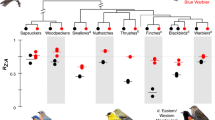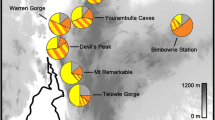Abstract
If alternative phenotypes in polymorphic populations do not mate randomly, they can be used as model systems to study adaptive diversification and possibly the early stages of sympatric speciation. In this case, non random mating is expected to support genetic divergence among the different phenotypes. In the present study, we use population genetic analyses to test putatively neutral genetic divergence (of microsatellite loci) among three colour morphs of the lizard Podarcis melisellensis, which is associated with differences in male morphology, performance and behaviour. We found weak evidence of genetic divergence, indicating that gene flow is somewhat restricted among morphs and suggesting possible adaptive diversification.

Similar content being viewed by others

References
Belkhir K, Borsa P, Chikhi L, Raufaste N, Bonhomme F (1996–2004) GENETIX 4.05, logiciel sous Windows TM pour la génétique des populations. Laboratoire Génome, Populations, Interactions, CNRS UMR 5171, Université de Montpellier II, Montpellier (France)
Belkhir K, Castric V, Bonhomme F (2002) IDENTIX, a software to test for relatedness in a population using permutation methods. Mol Ecol Notes 2:611–614. doi:10.1046/j.1471-8278.2002.00273.x
Bleay C, Sinervo B (2007) Discrete genetic variation in mate choice and a condition-dependent preference function in the side-blotched lizard: implications for the formation and maintenance of coadapted gene complexes. Behav Ecol 18:304–310. doi:10.1093/behaco/arl101
Bolnick DI, Fitzpatrick BM (2007) Sympatric speciation: models and empirical evidence. Annu Rev Ecol Evol Syst 38:459–487. doi:10.1146/annurev.ecolsys.38.091206.095804
Brockmann HJ, Taborsky M (2008) Alternative reproductive tactics and the evolution of alternative allocation phenotypes. In: Oliveira R, Taborsky M, Brockmann HJ (eds) Alternative reproductive tactics. Cambridge University Press, Cambridge, pp 25–51
Brookfield JFY (1996) A simple new method for estimating null allele frequency from heterozygote deficiency. Mol Ecol 5:453–455
Chakraborty R, De Andrade M, Daiger SP, Budowle B (1992) Apparent heterozygote deficiencies observed in DNA typing data and their implications in forensic applications. Ann Hum Genet 56:45–47
Coyne JA, Orr HA (2004) Speciation. Sinauer Associates, Sunderland
Dakin EE, Avise JC (2004) Microsatellite null alleles in parentage analysis. Heredity 93:504–509. doi:10.1038/sj.hdy.6800545
Ford EB (1945) Polymorphism. Biol Rev 20:73–88
Forsman A, Appelqvist S (1998) Visual predators impose correlational selection on prey color pattern and behavior. Behav Ecol 9:409–413
Forsman A, Ahnesjö J, Caesar S, Karlsson M (2008) A model of ecological and evolutionary consequences of color polymorphism. Ecology 89:34–40
Funk DJ, Filchak KE, Feder JL (2002) Herbivorous insects: model systems for the comparative study of speciation ecology. Genetica 116:251–267
Gavrilet S, Waxman D (2002) Sympatric speciation by sexual conflict. Proc Natl Acad Sci USA 99:10533–10538. doi:10.1073/pnas.152011499
Goudet J (1995) A computer program to calculate f-statistics. J Hered 86:485–486
Härdling R, Bergsten J (2006) Nonrandom mating preserves intrasexual polymorphism and stops population differentiation in sexual conflict. Am Nat 167:401–409
Hendry AP, Huber SK, De León LF, Herrel A, Podos J (2009) Disruptive selection in a bimodal population of Darwin’s finches. Proc R Soc Lond B 276:753–759. doi:10.1098/rspb.2008.1321
Huber SK, De Leon LF, Hendry AP, Bermingham E, Podos J (2007) Reproductive isolation of sympatric morphs in a population of Darwin’s finches. Proc R Soc Lond B 274:1709–1714. doi:10.1098/rspb.2007.0224
Huyghe K, Vanhooydonck B, Herrel A, Tadic Z, Van Damme R (2007) Morphology, performance, behavior and ecology of three color morphs of the lizard Podarcis melisellensis. Integr Comp Biol 47:211–220. doi:10.1093/icb/icm043
Huyghe K, Herrel A, Adriaens D, Tadic Z, Van Damme R (2009a) It is all in the head: morphological basis for differences in bite force among colour morphs of the Dalmatian wall lizard. Biol J Linn Soc 96:13–22
Huyghe K, Breugelmans K, Small M, Tadic Z, Van Damme R, Vanhooydonck B, Backeljau T (2009b) Characterization of polymorphic microsatellite markers in the Dalmatian wall lizard Podarcis melisellensis (Squamata: Lacertidae). Mol Ecol Resour 9:299–301. doi:10.1111/j.1755-0998.2008.02381.x
Johannessen K, Havenhand JN, Jonsson PR, Lindegarth M, Sundin A, Hollander J (2008) Male discrimination of female mucous trails permits assortative mating in a marine snail species. Evolution 62:3178–3184. doi:10.1111/j.1558-5646.2008.00510.x
Koblmüller S, Sefc KM, Duftner N, Katongo C, Tomljanovic T, Sturmbauer C (2008) A single mitochondrial haplotype and nuclear genetic differentiation in sympatric colour morphs of a riverine cichlid fish. J Evol Biol 21:362–367. doi: 10.1111/j.1420-9101.2007.01443.x
Lande R, Arnold SJ (1983) The measurement of selection on correlated characters. Evolution 37:1210–1226
Lande R, Kirkpatrick M (1986) Ecological speciation by sexual selection. J Theor Biol 133:85–98
Latch EK, Dharmarajan G, Glaubitz JC, Rhodes OE Jr (2006) Relative performance of Bayesian software for inferring population substructure and individual assignment at low levels of population differentiation. Conserv Genet 7:295–302. doi:10.1007/s10592-005-9098-1
Linn CE Jr, Dambroski HR, Feder JL, Berlocher SH, Nojima S, Roelofs WL (2004) Postzygotic isolation factor in sympatric speciation in Rhagoletis flies: reduced response of hybrids to parental host-fruit odors. Proc Natl Acad Sci USA 101:17753–17758. doi:10.1073/pnas.0408255101
Matsubayashi KW, Ohshima I, Nosil P (2009) Ecological speciation in phytophagous insects. Entomol Exp Appl 134:1–27. doi:10.1111/j.1570-7558.2009.00916.x
McKinnon JS, Rundle HD (2002) Speciation in nature: the threespine stickleback model systems. TREE 17:480–488
Meyers JJ, Irschick DJ, Vanhooydonck B, Herrel A (2006) Divergent roles for multiple sexual signals in a polygynous lizard. Funct Ecol 20:709–716. doi:10.1111/j/1365-2435.2006.01152.x
Oliveira RF, Taborsky M, Brockmann HJ (2008) Alternative reproductive tactics, an integrative approach. Cambridge University Press, Cambridge
Pritchard JK, Stephens M, Donnelly P (2000) Inference of population structure using multilocus genotype data. Genetics 155:945–959
Pryke SR, Griffith SC (2006) Red dominates black: agonistic signaling among head morphs in the colour polymorphic Gouldian finch. Proc R Soc Lond B 273:949–957. doi:10.1098/rspb.2005.3362
Pryke SR, Griffith SC (2007) The relative role of male vs female mate choice in maintaining assortative pairing among discrete colour morphs. J Evol Biol 20:1512–1521. doi:10.1111/j.1420-9101.2007.01332.x
Pryke SR, Griffith SC (2009) Postzygotic genetic incompatibility between sympatric color morphs. Evolution 63:793–798. doi:10.1126/science.1168928
Puebla O, Bermingham E, Guichard F, Whiteman E (2007) Colour pattern as a single trait driving speciation in Hypoplectrus coral reef fishes? Proc R Soc Lond B 274:1265–1271. doi:10.1098/rspb.2006.0435
Queller DC, Goodnight KF (1989) Estimating relatedness using genetic markers. Evolution 43:258–275
Raymond M, Rousset F (1995) Genepop version 1.2: population genetics software for exact tests and ecumenicism. J Hered 86:248–249
Ritchie MG (2007) Sexual selection and speciation. Annu Rev Ecol Evol Syst 38:79–102. doi:10.1146/annurev.ecolsys.38.091206.095733
Sinervo B, Svensson E (2002) Correlational selection and the evolution of genomic architecture. Heredity 89:329–338
Sinervo B, Svensson E, Comendant T (2000) Density cycles and an offspring quantity and quality game driven by natural selection. Nature 406:985–988
Sinervo B, Heulin B, Surget-Groba Y, Clobert J, Miles DB, Corl A, Chaine A, Davis A (2007) Models of density-dependent genic selection and a new rock-paper-scissors social system. Am Nat 170:663–680. doi:10.1086/522092
Small MP, Beacham T, Withler R, Nelson RJ (1998) Discriminating coho salm (Oncorhynchus kisutch) populations within the Fraser River, British Columbia using microsatellite DNA markers. Mol Ecol 7:141–155
Smith TB, Skúlason S (1996) Evolutionary significance of resource polymorphisms in fish, amphibians and birds. Annu Rev Ecol Syst 27:111–133
Svensson E, Abbott JK, Gosden TP, Coreau A (2009) Female polymorphisms, sexual conflict and limits to speciation processes in animals. Evol Ecol 23:93–108. doi:10.1007/s10682-007-9208-2
Van Doorn GS, Weissing FJ (2001) Ecological versus sexual selection models of sympatric speciation: a synthesis. Selection 2:17–40
Van Doorn GS, Dieckmann U, Weissing FJ (2004) Sympatric speciation by sexual selection: a critical reevaluation. Am Nat 163:709–725
Wagner AP, Creel S, Kalinowski ST (2006) Estimating relatedness and relationships using microsatellite loci with null alleles. Heredity 97:336–345. doi:10.1038/sj.hdy.6800865
Walter RP, Haffner GD, Heath DD (2009) No barriers to gene flow among sympatric polychromatic ‘small’ Telmatherina antoniae from Lake Matano, Indonesia. J Fish Biol 74:1804–1815. doi:10.1111/j.1095-8649.2009.02256.x
Weir BS, Cockerham CC (1984) Estimating F-statistics for the analysis of population structure. Evolution 38:1358–1370
West-Eberhard MJ (2005) Developmental plasticity and the origin of species differences. Proc Natl Acad Sci USA 102:6543–6549. doi:10.1073/pnas.0501844102
Acknowledgments
We would like to thank W.J. Etges and two anonymous reviewers for comments on earlier versions of this paper. We also thank Karin Breugelmans (RBINS) for help in the lab and Patricija Okovič for help in the field. Bieke Vanhooydonck is a postdoctoral fellow of FWO-Vl. Samples were collected under permit no. 532-08-01/6-06-02 issued by the Croatian Ministry of Culture. This work was funded by an FWO-Vl research grant G.0111.06, a research grant of the University of Antwerp (BOF), and the Joint Experimental Molecular Unit (JEMU) at the RBINS.
Author information
Authors and Affiliations
Corresponding author
Rights and permissions
About this article
Cite this article
Huyghe, K., Small, M., Vanhooydonck, B. et al. Genetic divergence among sympatric colour morphs of the Dalmatian wall lizard (Podarcis melisellensis). Genetica 138, 387–393 (2010). https://doi.org/10.1007/s10709-010-9435-2
Received:
Accepted:
Published:
Issue Date:
DOI: https://doi.org/10.1007/s10709-010-9435-2



